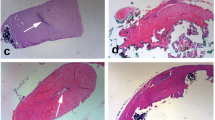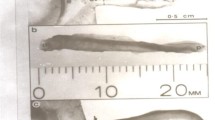Abstract
The purpose of this study is to describe a technique, that is as successful as microsurgery in terms of patency rates and histopathologic assessments, and can be performed even by untrained hands in microsurgery, for repairing vas deferens injuries that can be percieved during inguinal herniorrhaphy. Thirty male Wistar–Albino rats were randomly allocated to five groups. In control group, the vas deferens was harvested without any surgical intervention (Group 1) and in sham group the vas was harvested after a limited dissection (Group 2). Three suture approximation technique was carried out in Group 3, and a novel vasovasostomy technique was carried out by using a hypodermal needle in Groups 4 and 5, with polypropylene and polyglactin 910 (rapid vicryl®), respectively. Results were evaluated in terms of operative time, patency and flow rates, inflammation and sperm granuloma. The mean operative times for hypodermal needle assisted approximation of Groups 4 and 5 were found significantly less than Group 3. The compared results of the groups in terms of patency, flow rate, inflammation and spermatic granuloma indicated Group 4 to be superior to the other groups. We have found the hypodermal needle assisted approximation technique to be easier, less time consuming and cost effective. With these promising results, this modus operandi can be described as an appropriate technique for vas deferens transection repairs.



Similar content being viewed by others
References
Steigman CK, Sotelo-Avila C, Weber TR (1999) The incidence of spermatic cord structures in inguinal hernia sacs from male children. Am J Surg Pathol 23:880–885
Sheynkin YR, Hendin BN, Schlegel PN, Goldstein M (1998) Microsurgical repair of iatrogenic injury to the vas deferens. J Urol 159:139–141
Baskin LS, Kogan BA (1999) Hydrocele/hernia. In: Gonzales ET, Bauer SB (eds) Pediatric urology practice. Lippincott Williams &Wilkins, Philedelphia pp 649–653
Lee HY (1986) A 20-year experience with vasovasostomy. J Urol 136:413–415
Owen ER (2002) Microsurgical vasovasostomy: a reliable vasectomy reversal. 1977. J Urol 167:1205
Silber SJ (1977a) Microscopic vasectomy reversal. Fertil Steril 28:1191–1202
Silverstein JI, Mellinger BC (1991) Fibrin glue vasal anastomosis compared to conventional sutured vasovasostomy in the rat. J Urol 145:1288–1291
Harvey MH, Johnstone MJ, Fossard DP (1985) Inguinal herniotomy in children: a five year survey. Br J Surg 72:485–487
Sparkman RS (1962) Bilateral exploration in inguinal hernia in juvenile patients. Review and appraisal. Surgery 51:393–406
Donnellan WL (2001) Inguinal and femoral hernias. In: Donnellan WL, Burrington JD, Kimur K, Schafer JC, White JJ (eds) Abdominal surgery of infancy and childhood. Harwood Academic Publishers GmbH, Luxembourg pp 52/1–22
Grosfeld JL (1995) Hernias in children. In: Spitz L, Coran AG (eds) Rob & Smith’s operative surgery pediatric surgery. Chapman & Hall, UK, pp 222–238
Popek EJ (1990) Embryonal remnants in inguinal hernia sacs. Hum Pathol 21:339–349
Partrick DA, Bensard DD, Karrer FM, Ruyle SZ (1998) Is routine pathological evaluation of pediatric hernia sacs justified? J Pediatr Surg 33:1090–1092
Miller GG, McDonald SE, Milbrandt K, Chibbar R (2003) Routine pathological evaluation of tissue from inguinal hernias in children is unnecessary. Can J Surg 46:117–119
Silber SJ (1977b) Perfect anatomical reconstruction of the vas deferens with a new microscopic surgical technique. Fertil Steril 28:72–77
Fischer MA, Grantmyre JE (2000) Comparison of modified one- and two-layer microsurgical vasovasostomy. BJU Int 85:1085–1088
Vrijhof EJ, de Bruine A, Lycklama a Nijeholt AA, Koole LH (2004) A polymeric mini-stent designed to facilitate the vasectomy reversal operation. A rabbit model study. Biomaterials 25:729–734
Acknowledgments
The authors would like to thank Vet. Dr. Seyda Diker for her assistance in the research laboratory. And we also thank Dr. Billur Demirogullari for her illustrations.
Author information
Authors and Affiliations
Corresponding author
Rights and permissions
About this article
Cite this article
Ozen, I.O., Bagbanci, B., Demirtola, A. et al. A novel technique for vas deferens transection repairs. Pediatr Surg Int 22, 815–819 (2006). https://doi.org/10.1007/s00383-006-1734-4
Accepted:
Published:
Issue Date:
DOI: https://doi.org/10.1007/s00383-006-1734-4




